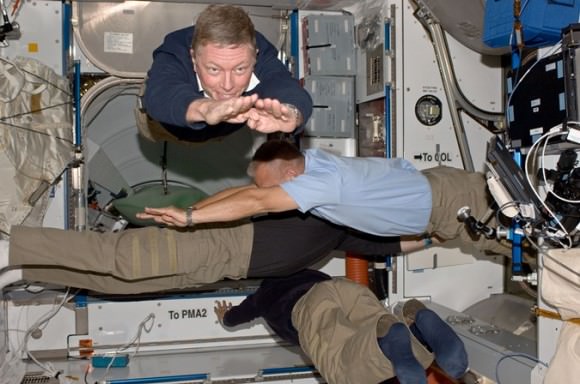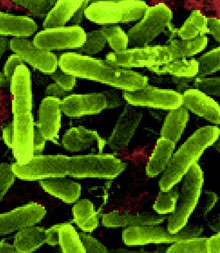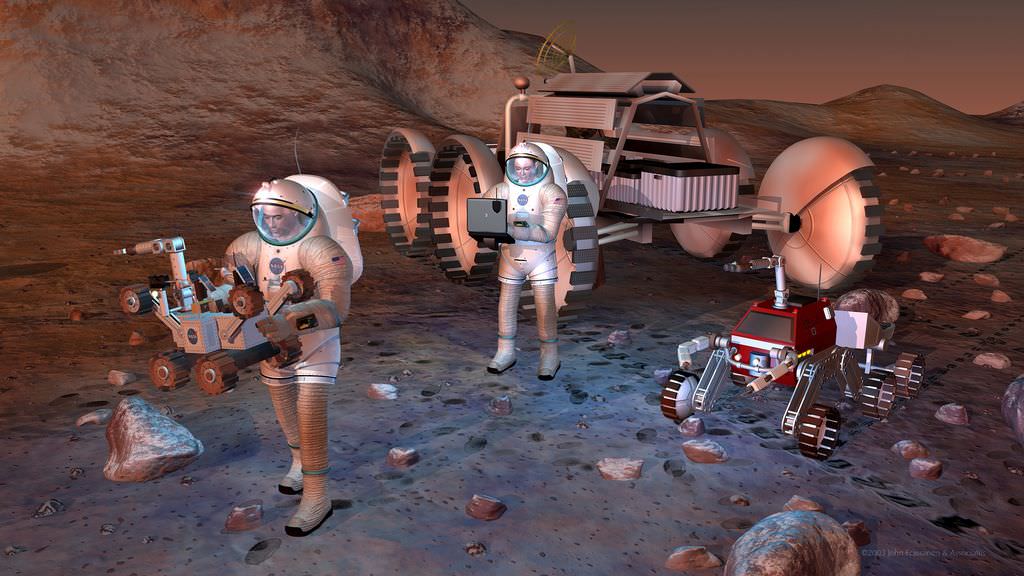We all love space here and we’re sure, given that thousands of people applied for a one-way trip to Mars, that at least some of you want to spend a long time in a spacecraft. But have you thought about the bacteria that will be going along with you?
If you don’t feel too squirmy to read on, understand this: one type of bacteria grown aboard two shuttle missions ended up being bigger and thicker than control colonies on Earth, new NASA research shows.
Two astronaut crews aboard space shuttle Atlantis grew colonies of bacteria (more properly speaking, biofilms) on behalf of researchers on Earth. Most biofilms are harmless, but a small number could be associated with disease.
Biofilms were all over the Mir space station, and managing them is also a “challenge” (according to NASA) on the International Space Station. Well, here’s how they appeared in this study:
“The space-grown communities of bacteria, called biofilms, formed a ‘column-and-canopy’ structure not previously observed on Earth,” NASA stated. “Biofilms grown during spaceflight had a greater number of live cells, more biomass, and were thicker than control biofilms grown under normal gravity conditions.”

The type of microorganism examined was Pseudomonas aeruginosa, which was grown for three days each on STS-132 and STS-135 in artificial urine. That was chosen because, a press release stated, “it is a physiologically relevant environment for the study of biofilms formed both inside and outside the human body, and due to the importance of waste and water recycling systems to long-term spaceflight.”
Each shuttle mission had several vials of this … stuff … in which to introduce the bacteria in orbit. The viles included cellulose membranes on which the bacteria could grow. Researchers also tested bacteria growth on Earth with similar vials. Then, all the samples were rounded up in the lab after the shuttle missions where the biofilms’ thickness, number of cells and volume was examined, as well as their structure.
This is still early-stage work, of course, requiring follow-up studies to find out how the low-gravity environment affects these microorganisms’ growth, according to lead researcher Cynthia Collins from the Rensselaer Polytechnic Institute. Metabolism and virulence are what the scientists are hoping to learn more about in the future.

“Before we start sending astronauts to Mars or embarking on other long-term spaceflight missions, we need to be as certain as possible that we have eliminated or significantly reduced the risk that biofilms pose to the human crew and their equipment,” stated Collins, an assistant professor in the department of chemical and biological engineering.
While this research has more immediate implications for astronaut health, the researchers added that better understanding the biofilms could lead to better treatment and prevention for Earth diseases.
“Examining the effects of spaceflight on biofilm formation can provide new insights into how different factors, such as gravity, fluid dynamics, and nutrient availability affect biofilm formation on Earth. Additionally, the research findings could one day help inform new, innovative approaches for curbing the spread of infections in hospitals,” a NASA press release stated.
If you’re not feeling too itchy by now, you can read the entire study in an April issue of PLOS ONE.
Credit: NASA


No small potatoes, this is a very real problem…. Imagine a simple case of tinea pedis (Athlete’s Foot) mutating into a life threatening organism? ACK!
Image of an area on the ISS where exercise clothes are hung to dry shows bacterial growth: http://science.nasa.gov/media/medialibrary/2007/05/11/11may_locad3_resources/fungus.jpg
Excerpt from NASA Science News: “In 1998, U.S. astronauts participating in the NASA 6 and NASA 7 visits to Mir collected environmental samples from air and surfaces in Mir’s control center, dining area, sleeping quarters, hygiene facilities, exercise equipment, and scientific equipment. Imagine their surprise when they opened a rarely-accessed service panel in Mir’s Kvant-2 Module and discovered a large free-floating mass of water. “According to the astronauts’ eyewitness reports, the globule was nearly the size of a basketball, Ott said.”
Back in the early 70’s I worked at a small company that supplied a variety of electronics related components for the aviation industry. One of the products we sold were a type of rubber cable supports. One day we opened a bulk container filled with these items and found the whole shipment covered with a white mold that was eating the ‘rubber’! (Not actually rubber, but a rubber-like synthetic)
“No small potatoes, this is a very real problem…. Imagine a simple case of tinea pedis (Athlete’s Foot) mutating into a life threatening organism?”
Nothing in this behavior was caused by mutations. Get back down to Earth.
This is just another reason why manned interplanetary journeys should probably be undertaken within spinning space habitats that produce artificial gravity. Deploying such artificial gravity habitats shouldn’t be too difficult with the enormous lifting capacity and larger fairing area that the SLS will provide in the 2020’s and 2030s.
Marcel F. Williams
Or, they could supply the astronauts with oxygen. =D
Good idea, who knows which morphotypes of biofilms and/or infections appears. And it would make surgery easier too.
But as always, it isn’t a show stopper. Just a question of balancing risks vs costs and development time.
Imagine if just a few bacteria-cells are missed coming back on an astronaut or their ship and gets into our earths atmosphere/air. I remember my grandmother -(born in 1898)- telling me about the deaths from consumption=TB. Tens of millions of men, woman and children died world wide like a plague. Makes one think of other negative possibilities.
P. aeruginosa is a soil bacteria, which is commonly opportunistic on skin (“bath rash”) and in urinary tracts. So it has gotten into “Earth’s atmosphere/air”, all over, and in most cases our immune systems can deal with it.
Yes again larsson, I agree up to a point. 99.44% will die. All it takes is a 0.46% (a few) microbe survivor’s Larsson. That is where I was going with my post. BTW, your name is written all over one microbe. Just my luck, there will be 2. One you for and I’d get the number two. –sneeze–
My point that they are already everywhere (or they wouldn’t have been picked for the mission).
Your point, I don’t get.
Yes, ..understood. Future travels hopefully will be free on contamination or fully contained. .
This type of contamination is scary.
This problem will seriously inhibit space flight in the future.
We have evolved with these organisms. Changing the culture medium by reducing the gravity will no doubt cause significant changes that we are not adapted too.
Bacteria adapt very quickly. We don’t !
“This problem will seriously inhibit space flight in the future.”
Claim in need of reference.
Sorry !
I should have said Space exploration. Meaning long term rather than just trips up and down.
Yes. I agree.
Thank you Sir. But I insist. You go first !
LOL…Lets do this the democratically. Lets flip for it. You flip, and I got heads. 😉
Ok !
Heads you go, Tails my feet stay here at 1G.
I hope you are not claustrophobic & that you have a head for heights .
Sorry I won’t be around when you get back .
Time dilation and all that.
Unless you can warp space time that is.
What is your preferred method of transport ?
LOL…your fun! Good man! Yes, heads I go 1st, tails you go 1st. 1G is perfect. My preferred transportation method is “Star Treks” transporter, Or better know as “Scotty the main engineer on “Star trek”. Beam me there Tony! Standing by now. Energize please ;-0… . See ya soon my fun friend 😉
That wasn’t the reference I asked for. You claim that they will inhibit space flight, but the article’s paper doesn’t make such a claim.
So why would we think this, or similar, morphotypes would seriously inhibit long term space flight?
The changed behavior of biofilms may or may not be a problem, but so far no “superpower” bacteria has turned up AFAIU.
The analogous morphotype forms under normal gravity as well, if biofilms encounter streaming water (think urine tract for P. aeruginosa). Mushroom-shaped, stalked biofilms that in vacuum apparently form a connected canopy instead.
It is arguable that the bacteria has derived some “superpower” trait. The new morphotype film is more productive in terms of number of stacked bacteria though.
Specifically for an aerobic bacteria as P. aeruginosa it will likely not form the new morphotype biofilm in normal body conditions at all. The presence of oxygen removed all the differences between normal gravity and microgravity. “Oxygen allowed the bacteria to build the biggest biofilms they could irrespective of the environment. It seems that the column and canopy structure is only important when bacteria don’t have the help of oxygen to release energy from their food.”
By the way, the paper got some heavy criticism, see the link:
“The statistical analysis appears to be completely missing from this paper. They list p values, but these statistical values of significance are effectively meaningless if we don’t know what statistical method the researchers used to obtain them.”
“The paper appears to treat gravity as if it has no direction. A biofilm is either being grown with the action of gravity upon it, or it is not. The question I would ask is whether biofilms grown in normal gravity grow differently if they are placed upside down, or balanced on their sides. If gravity has an effect on the way biofilms structure themselves, then the orientation of a biofilm relative to the earth’s gravitational field should also change the structure of the biofilm. In what orientation were the ground control cultures grown ?”